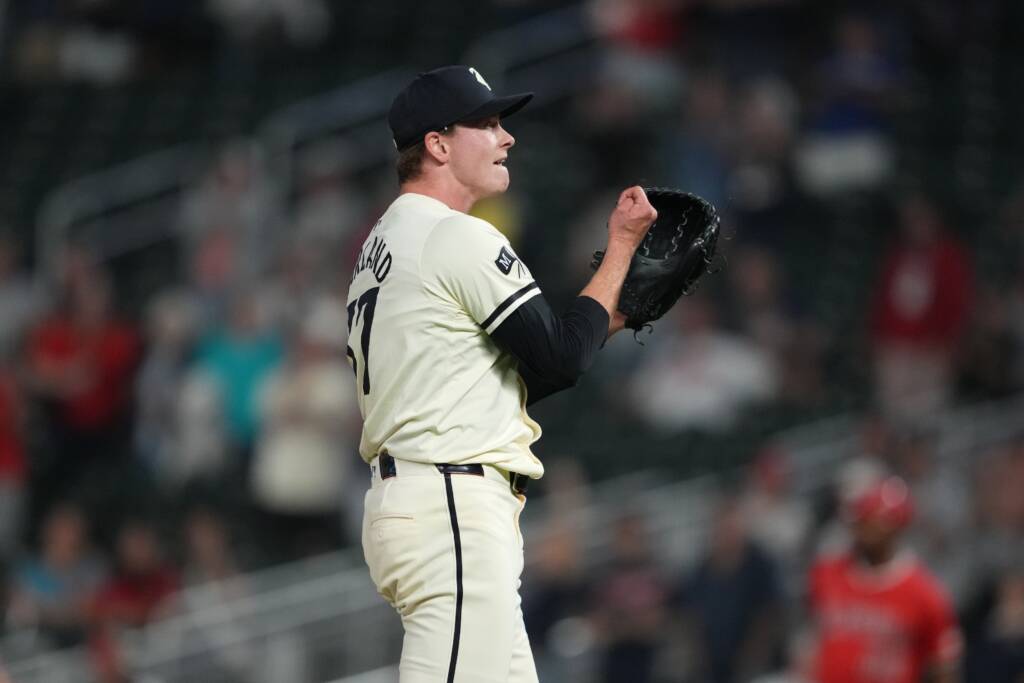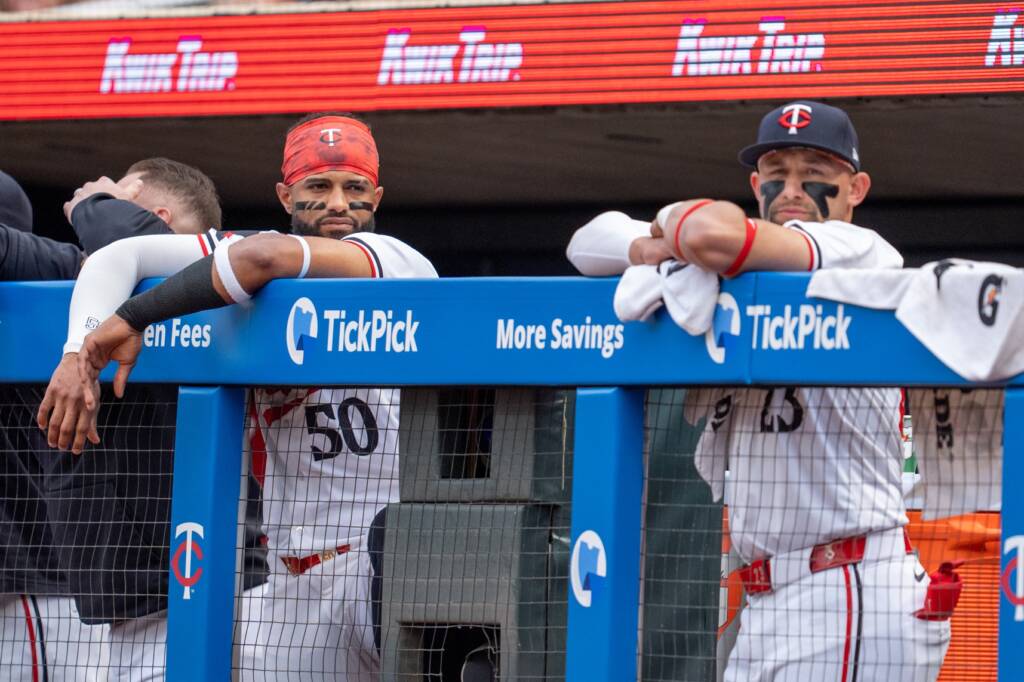There isn’t one thing to point to that explains the Minnesota Twins’ struggles this season.
There are the losses of borderline All-Star Joe Ryan and flamethrower Brock Stewart. The failed offseason attempt to bolster the bullpen with Steven Okert, Jay Jackson, and Josh Staumont. They’ve had a plethora of injuries to crucial defensive/offensive studs like Carlos Correa, Byron Buxton, and Royce Lewis. And Max Kepler (who has also missed time with knee issues) and Edouard Julien’s underwhelming performances.
Not all hope is lost. The Twins are still on pace to almost match their ZiPS preseason win total as they fight for a Wild Card spot. However, another critical factor has plagued Minnesota.
The absence of a solid long reliever.
The Twins have an innings problem. They’ve received only 5.378 innings per start from their starters this season, compared to 5.575 last year. That difference may not seem like much, but it’s a major contributor to Minnesota’s struggles.
Sonny Gray has been inconsistent with the St. Louis Cardinals, but he gave the Twins a dependable five-plus innings per start last season, averaging 5.75 innings per outing. Joe Ryan was averaging 5.87 innings per start before the Twins shut him down for the season with a teres major strain in August.
Pablo López has turned things around in the back half of the season, but he’s had shorter outings this season (5.86 innings per start vs. 6.06 last season).
Chris Paddack was not able to find his groove. However, his nearly 5.2 innings per start is a solid figure compared to the rest of Minnesota’s young and inexperienced rotation.
The young quartet of Simeon Woods Richardson, David Festa, Zebby Matthews, and Louie Varland have gone just 4.923, 4.583, 4.222, and 4.617 innings per start this season, respectively.
Varland is transitioning to a bullpen role, but the Twins have leaned heavily on the former three. However, Woods Richardson, Festa, and Matthews aren’t pitching deep into games. As a result, the bridge to Minnesota’s strong backend duo of Griffin Jax and Jhoan Duran (and Stewart when he was healthy) has been shaky.
There’s not much time left before the playoffs, but they’ve scheduled each of their young arms for at least two more starts. Low innings from starters may continue to be a problem.
Beyond the aforementioned offseason acquisitions of Okert, Jackson, and Staumont, who they brought in as medium-leverage middle relievers, Minnesota has yet to find a stable long reliever to help compensate for the starter’s lower innings totals.
Jax recently recorded six outs against the Los Angeles Angels on Sept. 7, earning a hold. He’s flashed the ability to go multiple innings in the past, but the ascension of his four-seamer and sweeper combo recently has allowed him to serve as a crucial late-inning arm for the Twins.
His 1.48 WPA/LI, which measures how many wins a pitcher is worth incorporating the severity of the situations they find themselves in, is nearly double that of Cole Sands, Minnesota’s second most valuable pitcher by WPA/LI with 0.77.
Duran has lost velocity, but he’s still found enough success in high-leverage spots.
Jax and Duran represent a strong final act in Minnesota’s pitching performance. They’ve still had some blow-up outings and blown saves but are generally reliable.
Cole Sands used to provide bulk innings, but a combination of an improved arsenal and a need for medium-leverage relievers has resulted in shorter stints. He pitched an average of 2.29 innings per relief outing as a rookie in 2022 but has gone just 1.2 innings this year.
The Twins are deploying Ronny Henriquez as their long reliever. However, he’s only been in that role (nearly) full-time since Aug. 17 and has made just 12 relief appearances.
However, he’s been effective in that time. He has a 2.60 ERA but a less inspiring 4.15 FIP. Despite the disparity in those numbers, he hasn’t made enough appearances to allow us to gauge what he could be in the future.
Henriquez has showcased an ability to keep the ball on the ground. His 53.3% ground ball rate is substantially higher than the 44.5% MLB average. He doesn’t induce whiffs, but his four-pitch mix works well to get him through multiple innings. Henriquez can make short work of batters with efficient at-bats and balls in play.
He has quality stuff across the board, with a 123 Stuff+ four-seamer, according to MLBPitchProfiler. Henriquez’s high velocity (90.6 mph) changeup bodes well for forcing grounders, and his sinker’s 90th percentile arm side location percentage (aLoc%) signifies he may be an effective jammer. Therefore, his ground ball rate is here to stay.
Henriquez is a name to watch for 2025, but he won’t be able to travel back in time to help the Twins when they needed him most in 2024.
Minnesota may be continuing to search for another multi-inning arm. Though it came at the expense of Jorge Alcala’s roster spot, the Twins could use waiver acquisition Cole Irvin in that way.
Irvin was a starter for much of his career and has the stamina and deep arsenal required for long relief work. Though it isn’t always consistent year-to-year, Irvin’s 101 Location+ suggests he also has solid command.
While he doesn’t have terrific stuff, Irvin’s low arm slot makes him intriguing. His four-seamer has 15.4 inches of induced vertical break, which is average. However, Jeremy Maschino’s MLBPitchProfiler model implies his four-seamer plays more like a 19+ IVB pitch with his low arm slot.
Nonetheless, Irvin hasn’t worked out as a starter thus far in his career, and he’ll likely continue to shift to the bullpen as he has in the past two seasons with the Baltimore Orioles. He could consolidate down to just a few pitches rather than the six pitches he currently throws, with his four-seamer and 97 Stuff+ gyro cutter representing the base.
His sweeping curveball and sinker theoretically give him two grounder-inducing pitches, with both pitches achieving at least a 56.3% or higher ground ball rate in one of the past two seasons.
Curveballs with more drop will typically result in more grounders. Irvin’s isn’t remarkable in this way, but curveballs usually effectively induce grounders. Irvin’s sinker is also unremarkable in terms of drop on the pitch, and he’s located his sinkers up in the zone (41% high location rate, 90th percentile), but it can still mitigate lift when he locates it low.
Varland could fill the void if Henriquez or Irvin aren’t the long-term option. The door is still open for him to fulfill his destiny as a starter. However, should he fully transition to the bullpen, his high-velocity four-seamer and gyro slider are always there for him.
Those two pitches, in tandem with his 105 Stuff+ knuckle-curve, could serve as a solid mix to get through 2-3 innings. It’s just as possible Varland could flourish as some sort of Stewart variant.
Stewart incorporates an otherworldly “super sweeper” in his pitch mix, but the basis of a four-seamer/slider is akin to Varland. Stewart and Varland could serve as medium to high-leverage options in the future.
While the lack of a steady long reliever has plagued the Twins throughout the season, having a two-inning reliever is less important in the playoffs. With just López, Ober, and likely Woods-Richardson expected to make playoff starts (should Minnesota hold onto its Wild Card spot), the Twins should be able to learn more heavily on one-inning appearances from its bullpen.
Next season, though, Minnesota may need to find a more reliable long reliever.

